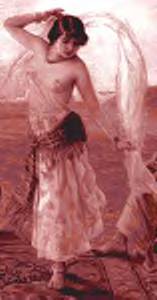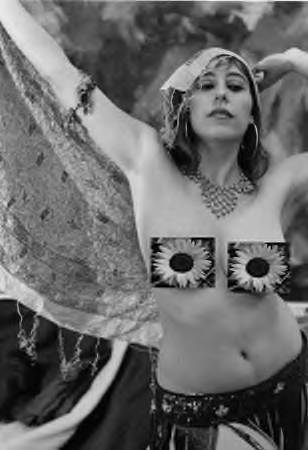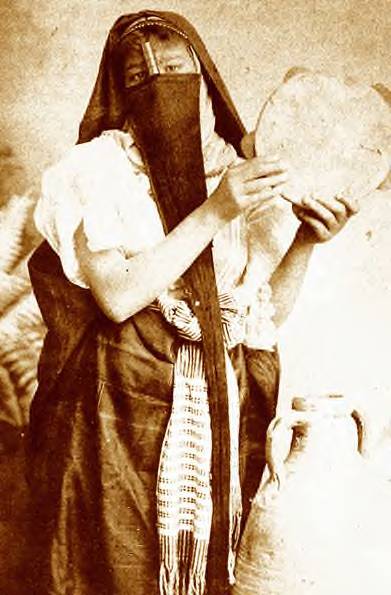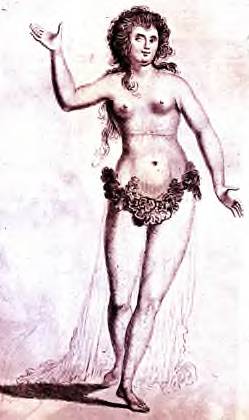|
|
|
|
 |
 |
|
The Art of Costuming by Monique Monet (Originally published in Jareeda Magazine) |
|
 |
 |
|
In a letter to Dear Abbey a woman asked for advise about how she could meet nice
"clean-cut" men; it seemed the only guys who ever approached her were the wild, outlaw biker type. In the course of her letter she mentioned that although she was straight-laced and conservative in her actual
lifestyle, her personal clothing style included lots of black leather, highlighted with chromed zippers and studs. |
 |
 |
|
Abbey explained to her (duh!) that the clothes we choose to wear are interpreted by most people as a loud
and clear statement of who we are. A black leather jacket and motorcycle boots jingling with chains are probably not the best fashion choice if you desire to hang out with the Kiwanis Club crowd.
And even more than everyday clothing, our dance costumes announce who and what we are - - or at the very least, who and what we want other people to think
we are. Dancers are performers. By broad definition, we're all to some extent or another, considered a part of "show biz". Our costumes are a powerful part of our persona. As dancers on stage we are, for those magic moments
, archetypal beings. And regular people gather together as an audience to be entertained and inspired by us colorful, vibrant, flamboyant, living archetypes. Our costumes are a
first and continuing statement of our creative expression; and a major component in the magic we strive to create through dance. We each say who we are via our choice in costumes. But often
it seems we are speaking entirely different languages: For many performers, their dance clothing is an intentional exercise in careful, graceful conformity - - a badge of membership in their chosen sorority. Their
costumes identify them as members of a particular segment of the dance world: Traditional Middle-Eastern Tribal, American Tribal Style, Egyptian Raq Sharqi, Modern Cabaret, etc., etc. |
|
|
 |
 |
|
Increasingly there are performers who view Middle Eastern Dance as a living, growing art
form. These dancers have no desire to identify themselves with any established group, and their choice in costuming reflects their independent thought. |
|
 |
 |
|
I believe that dance is art; and therefore dance expression should not be inhibited by any type of
societal constraint. Since costuming is an integral part of our dance, costuming is also a critical and important aspect of our creative artistic expression. |
 |
 |
|
For some
people dance ceases to be an art form and becomes merely a hobby or hack work
when the dancer's performance (including her costume) is limited and restrained by official regulation, or even by the sniffs and glares of organized ostracization. The dancer is the artist, and as such should enjoy the creative freedom to present her kinetic art dressed as she feels is necessary, whether clad head-to-feet in traditional Mid-East garb, or wearing nothing more than a securely inserted ostrich feather.
|
|
|
 |
Allowing and even encouraging dancers in creative and totally free-form costuming doesn't mean, as the
many rules-and-regulation types fear, that our dance performances will degenerate into an orgy of lasciviousness and perversion. Because in art, as in all aspects of natural life, nature regulates itself. The untalented
sensationalist, and the desperate exhibitionist will sink out of sight under the weight of their own tackiness and crudity. And the sincere dance artist, clad in head-to-foot cloak or ostrich feather or anything in
between, will enjoy a greater opportunity to fly to new heights of creative achievement. |
|
|
 |
 |
|
Modern world-wide Middle Eastern Dance is an art form growing ever broader and deeper in
scope. And I feel it's important we in the dance world maintain a broad and open-minded attitude toward our sister dancers - - however creative (or bizarre) their dance or costume choices might seem to us.
Freedom, variety, novelty, experimentation, as well |
|
 |
 |
|
as the priceless treasures of tradition, all make our dance more vibrant and alive. |
 |
 |
|
Costuming is an expression of who we are; and whether it's a statement of group solidarity or of
individuality, it's still an artistically valid expression. Excuse the hyperbole as I paraphrase the great French philosopher Voltaire: I may not like or approve of the costume you chose,
but I will defend to the death your right to wear it! |
 |
 |
|
All rights reserved |
|























